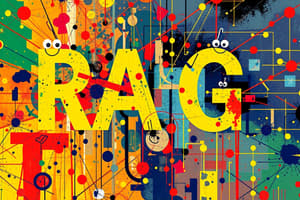Podcast
Questions and Answers
What is a primary function of the retriever in the RAG model?
What is a primary function of the retriever in the RAG model?
- To update the generative model without user intervention
- To fetch relevant documents from a knowledge base (correct)
- To perform extensive computations for scaling knowledge
- To generate coherent text based on user input
Which of the following is NOT considered an advantage of Retrieval Augmented Generation?
Which of the following is NOT considered an advantage of Retrieval Augmented Generation?
- Knowledge scalability to manage extensive data
- Elimination of any need for computing resources (correct)
- Improved accuracy through external information
- Dynamic updates to the knowledge base
What is the primary challenge related to the quality of retrieval in RAG?
What is the primary challenge related to the quality of retrieval in RAG?
- The relevance and effectiveness of the retrieved documents (correct)
- Latency in response due to retrieval
- The scalability of documents retrieved
- The size of the generative model required
Which variant of RAG utilizes a straightforward embedding for document retrieval?
Which variant of RAG utilizes a straightforward embedding for document retrieval?
In the process of RAG, what comes directly after the input query?
In the process of RAG, what comes directly after the input query?
How can RAG improve its generative capabilities in the future?
How can RAG improve its generative capabilities in the future?
What is a significant drawback of using RAG compared to purely generative models?
What is a significant drawback of using RAG compared to purely generative models?
Which application is NOT typically associated with the Retrieval Augmented Generation approach?
Which application is NOT typically associated with the Retrieval Augmented Generation approach?
Flashcards
RAG Definition
RAG Definition
Combines retrieval-based methods and generative models to enhance content using external knowledge.
Retriever Role in RAG
Retriever Role in RAG
Searches for relevant documents from a knowledge base using techniques like embeddings and TF-IDF.
Generator Role in RAG
Generator Role in RAG
A generative model that produces text using both the user's input and the retrieved documents as context.
RAG Process Steps
RAG Process Steps
Signup and view all the flashcards
Advantages of RAG
Advantages of RAG
Signup and view all the flashcards
Applications of RAG
Applications of RAG
Signup and view all the flashcards
Challenges of RAG
Challenges of RAG
Signup and view all the flashcards
RAG Variants
RAG Variants
Signup and view all the flashcards
Study Notes
Retrieval Augmented Generation (RAG)
-
Definition: RAG combines retrieval-based methods and generative models to enhance the quality of generated content using external knowledge sources.
-
Components:
- Retriever:
- Searches for relevant documents or passages from a knowledge base or database.
- Utilizes techniques like embeddings, TF-IDF, or BM25 for matching queries with documents.
- Generator:
- A generative model (e.g., transformer-based) that produces text.
- Takes both the user's input and the retrieved documents as context for generation.
- Retriever:
-
Process:
- Input Query: A user provides a question or a prompt.
- Document Retrieval:
- The retriever fetches relevant documents or snippets related to the query.
- Contextual Generation:
- The generator uses the query and retrieved documents to produce a coherent response or text.
-
Advantages:
- Improved Accuracy: By sourcing external information, responses can be more accurate and informative.
- Knowledge Scalability: Reduces the burden of embedding extensive knowledge within the model, allowing more flexibility.
- Dynamic Updates: Easy to update the knowledge base without retraining the model.
-
Applications:
- Question Answering Systems
- Conversational Agents
- Content Creation Tools
- Document Summarization
-
Challenges:
- Quality of Retrieval: The effectiveness hinges on the quality and relevance of the retrieved documents.
- Latency: Retrieval may introduce delays in response times compared to purely generative models.
- Model Size: The combined approach can be computationally intensive, requiring significant resources.
-
Variants:
- Simple RAG: Uses a straightforward embedding for retrieval.
- Dense RAG: Implements more sophisticated neural retrieval methods for better accuracy.
-
Future Directions:
- Exploring more efficient retrieval techniques.
- Enhancing generative models with better integration of retrieved data.
- Expanding use cases across different domains such as healthcare, law, and education.
Retrieval Augmented Generation (RAG)
- Definition: Combines retrieval-based methods and generative models for enhanced content creation using external knowledge sources.
- Key components: Retriever and generator.
- Retriever:
- Searches for relevant documents or passages from a knowledge base or database.
- Utilizes techniques like embeddings, TF-IDF, or BM25 for matching queries with documents.
- Generator:
- A generative model like a transformer-based model that produces text, taking both the user's input and retrieved documents as context.
- Process:
- User provides a query or prompt.
- The retriever fetches relevant documents or snippets related to the query.
- The generator leverages the query and retrieved documents to generate a coherent response or text.
- Advantages:
- Improved accuracy by accessing external information.
- Knowledge scalability, reducing dependence on internal model knowledge.
- Dynamic updates where the knowledge base can be easily updated without retraining the model.
- Applications:
- Question Answering Systems
- Conversational Agents
- Content Creation Tools
- Document Summarization
- Challenges:
- Quality of Retrieval: Effectiveness depends on the quality and relevance of retrieved documents.
- Latency: Retrieval can introduce delays in responses compared to generative models.
- Model Size: The combined approach can be computationally intensive.
- Variants:
- Simple RAG: Utilizes basic embeddings for retrieval.
- Dense RAG: Employs more sophisticated neural retrieval methods for improved accuracy.
- Future Directions:
- Exploring more efficient retrieval techniques.
- Enhancing generative models with better integration of retrieved data.
- Expanding applications across diverse domains such as healthcare, law, and education.
Studying That Suits You
Use AI to generate personalized quizzes and flashcards to suit your learning preferences.




